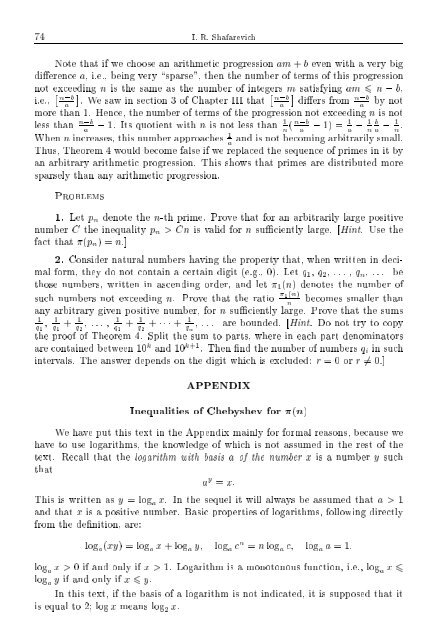SELECTED CHAPTERS FROM ALGEBRA I. R. Shafarevich Preface
SELECTED CHAPTERS FROM ALGEBRA I. R. Shafarevich Preface
SELECTED CHAPTERS FROM ALGEBRA I. R. Shafarevich Preface
You also want an ePaper? Increase the reach of your titles
YUMPU automatically turns print PDFs into web optimized ePapers that Google loves.
74 I. R. <strong>Shafarevich</strong>Note that if we choose an arithmetic progression am + b even with a very bigdierence a, i.e., being very \sparse", then the number of terms of this progressionnot exceeding n is the same as the number of integers m satisfying am 6 n ; b,i.e., n;ba . We saw in section 3 of Chapter III that n;ba diers fromn;baby notmore than 1. Hence, the number of terms of the progression not exceeding n is notless than n;ba; 1. Its quotient withn is not less than 1 n ( n;ba; 1) = 1 a ; 1 bn a ; 1 n .When n increases, this number approaches 1 aand is not becoming arbitrarily small.Thus, Theorem 4 would become false if we replaced the sequence of primes in it byan arbitrary arithmetic progression. This shows that primes are distributed moresparsely than any arithmetic progression.Problems1. Let p n denote the n-th prime. Prove that for an arbitrarily large positivenumber C the inequality p n >Cnis valid for n suciently large. [Hint. Use thefact that (p n )=n.]2. Consider natural numbers having the property that, when written in decimalform, they do not contain a certain digit (e.g., 0). Let q 1 , q 2 , ... , q n , ... bethose numbers, written in ascending order, and let 1 (n) denotes the number ofsuch numbers not exceeding n. Prove thatthe ratio 1(n)nbecomes smaller thanany arbitrary given positive number, for n suciently large. Prove that the sums1 1q 1,q 1+ 11q 2,...,q 1+ 1 q 2+ + 1q n,... are bounded. [Hint. Do not try to copythe proof of Theorem 4. Split the sum to parts, where in each part denominatorsare contained between 10 k and 10 k+1 . Then nd the number of numbers q i in suchintervals. The answer depends on the digit which is excluded: r =0orr 6= 0.]APPENDIXInequalities of Chebyshev for (n)We have put this text in the Appendix mainly for formal reasons, because wehave to use logarithms, the knowledge of which isnot assumed in the rest of thetext. Recall that the logarithm with basis a of the number x is a number y suchthata y = x:This is written as y =log a x. In the sequel it will always be assumed that a>1and that x is a positive number. Basic properties of logarithms, following directlyfrom the denition, are:log a (xy) =log a x +log a y log a c n = n log a c log a a =1:log a x>0 if and only if x>1. Logarithm is a monotonous function, i.e., log a x 6log a y if and only if x 6 y.In this text, if the basis of a logarithm is not indicated, it is supposed that itis equal to 2 log x means log 2 x.
















